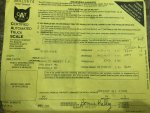Does anyone happen to have door stickers of a XLT or lariat for 150 and 250 (extended cab long bed 4x4)? Heck lets throw in a 350 also (although I doubt there is a huge difference between 250 and 350)
I'm curious about the curb weight of a optioned out (hey call me old) xlt or lariat so I can compare with my current OBS and calculate what the payload capacity ends up being - since what is online is 'max available' and not realistic with given options.
Also, anyone happen to know the curb weight of a OBS 7.3 CCLB? I weighed mine once (sticker below) but I think that was with a bunch of stuff in the bed. THere is also a old gooseneck and super heavy bumper extension (probably 300 pounds in itself) from the previous owner I plan on removing if keeping the OBS. Just want to do a little comparison to see what, payload wise, a new rig actually gets me aside from upgraded components and more comforts.
View attachment 680628





